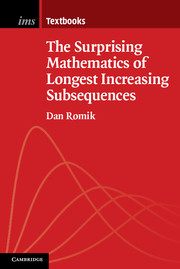Book contents
- Frontmatter
- Contents
- Preface
- 0 A few things you need to know
- 1 Longest increasing subsequences in random permutations
- 2 The Baik–Deift–Johansson theorem
- 3 Erdős–Szekeres permutations and square Young tableaux
- 4 The corner growth process: limit shapes
- 5 The corner growth process: distributional results
- Appendix Kingman's subadditive ergodic theorem
- Notes
- References
- Index
5 - The corner growth process: distributional results
Published online by Cambridge University Press: 05 October 2014
- Frontmatter
- Contents
- Preface
- 0 A few things you need to know
- 1 Longest increasing subsequences in random permutations
- 2 The Baik–Deift–Johansson theorem
- 3 Erdős–Szekeres permutations and square Young tableaux
- 4 The corner growth process: limit shapes
- 5 The corner growth process: distributional results
- Appendix Kingman's subadditive ergodic theorem
- Notes
- References
- Index
Summary
Chapter summary. In 1997, Kurt Johansson discovered that the corner growth process we studied in the previous chapter is directly related to longest increasing subsequences in generalized permutations. This connection can be studied via the RSK algorithm, which is an extension of the Robinson-Schensted algorithm discussed in Chapter 1, leading to a remarkable explicit representation for the distribution of the passage times, that is itself related to Wishart matrices from random matrix theory. Applying ideas from the theory of orthogonal polynomials and asymptotic analysis techniques, we prove Johansson's result that the distribution of the passage times converges to the Tracy-Widom distribution F2.
The fluctuations of G(m, n) and the Tracy–Widom distribution
In previous chapters we studied two natural processes of randomly growing Young diagrams, and derived the limiting shapes for both: the Plancherel growth process, which was used in Chapter 1 to solve the Ulam-Hammersley problem of deriving the (first-order) asymptotics of the maximal increasing subsequence length in a random permutation; and the corner growth process, which we analyzed in Chapter 4, where we also saw it bears an interesting relation to other natural random processes such as the totally asymmetric simple exclusion process and random domino tilings.
Information
- Type
- Chapter
- Information
- The Surprising Mathematics of Longest Increasing Subsequences , pp. 273 - 332Publisher: Cambridge University PressPrint publication year: 2015
